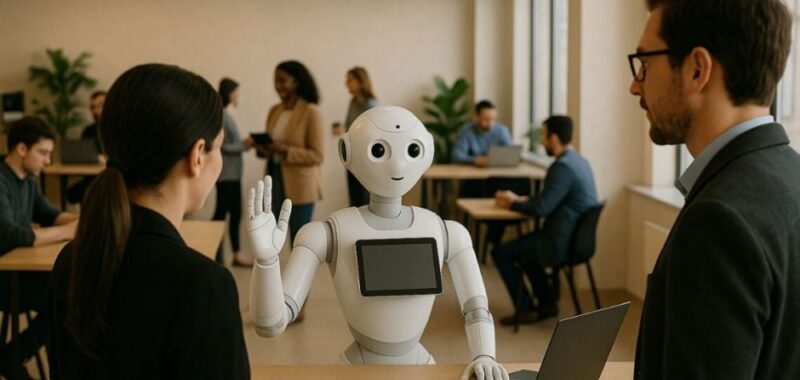It’s no longer unthinkable to consider a robotic receptionist or AI-powered assistant welcoming members, managing bookings, or even offering local lunch recommendations with a smile (or at least a programmed one).
- AI robots are already teaching classes and moderating debates, showing potential in coworking spaces.
- Coworking centers may use AI receptionists to cut costs and improve efficiency, but human connection remains essential.
- The integration of AI in coworking spaces does bring up concerns about liability, ethics, and the future of human jobs.
Article originally posted on Allwork.space.
In 1984, CEO of Alliance Virtual Offices Frank Cottle ran an experiment that, at the time, felt straight out of science fiction — a holographic receptionist. It was operationally successful: the hologram, powered by a live person behind the scenes, could “be” in multiple locations at once, greeting clients and handling inquiries. But despite the functional efficiency, there was a problem: people found it too weird.
“It worked,” Cottle said, “But clients didn’t like it. They missed the direct human interaction (even though an actual person ‘was’ the holograph).”
Fast-forward to today, and AI has progressed in ways no one could have imagined four decades ago. Tools like ChatGPT and virtual avatars are already being used for everything from customer support to teaching university courses.
Just last December, a high school in Germany became the first to host a humanoid robot teacher, called Captcha, who led an interactive lecture on how AI and human thinking differ, before moderating a debate on complex ethical topics like AI relationships, financial autonomy, and legal responsibility for AI-made decisions.
The robot, developed by Hidoba Research, even spoke to journalists and has been spotted riding public transport in the U.S. While its hardware may not be state-of-the-art, its natural speech and multi-language capabilities demonstrate how quickly AI is moving from labs and novelty showcases into real-world human environments: schools, campuses, and potentially places of work.
And with AI-powered robots like Captcha now delivering college lectures, the question isn’t if automation will show up in coworking centers — but when, how, and who will do it first.
AI Receptionists in Shared Workspaces
Coworking centers thrive on community, flexibility, and service — three elements that traditionally depend on human interaction. But as AI becomes more capable, it’s no longer unthinkable to consider a robotic receptionist or AI-powered assistant welcoming members, managing bookings, or even offering local lunch recommendations with a smile (or at least a programmed one).
The motivation? Efficiency and cost.
Staffing a front desk across multiple locations can be expensive. But a smart, AI-driven avatar (capable of learning, adapting, and handling thousands of requests simultaneously) could serve dozens of coworking spaces at a fraction of the cost. Add in facial recognition, natural language processing, and integration with workspace platforms, and you’ve got a virtual concierge who never sleeps, calls in sick, or takes lunch breaks.
The Human Touch vs. Digital Precision
But just because we can replace a human with a robot…should we?
The 1984 experiment already proved that even technologically impressive solutions can backfire if they alienate users. In coworking spaces, where hospitality is part of the product, AI must strike a delicate balance between convenience and coldness.
Others see AI as a potential collaborator, not a replacement. A hybrid approach, where AI handles repetitive admin tasks and humans focus on building relationships and community, may be the most effective model.

